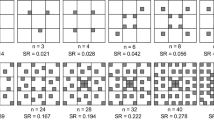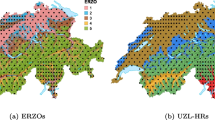Abstract
Weeds are species of interest for ecologists because they are competitors of the crop for resources but they also play an important role in maintaining biodiversity in agroecosystems. To study their spatial distribution at the field scale, only sampled observations are available due to the cost of sampling. Weeds sampling strategies are static. However, in the domain of spatial sampling, adaptive strategies have also been developed with, for some of them, an important on-line or off-line computational cost. In this article we provide answers to the following question: Are the current adaptive sampling methods efficient enough to motivate a wider use in practice when sampling a weed species at a field scale? We provide a comparison of the behaviour of 8 static strategies and 3 adaptive ones on four criteria: density class estimation, map restoration, spatial aggregation estimation, and sampling duration. From two weeds data sets, we estimated six contrasted Markov Random Field (MRF) models of weed density class spatial distribution and a model for sampling duration. The MRF models were then used to compare the strategies on a large set of simulated maps. Our main finding was that there is no clear gain in using adaptive sampling strategies rather than static ones for the three first criteria, and adaptive strategies were associated to longer sampling duration. This conclusion points out that for weed mapping, it is more important to build a good model of spatial distribution, than to propose complex adaptive sampling strategies.



Similar content being viewed by others
Notes
See the description of system S2 in Table 1 of Chikowo et al. (2009) for a complete description of the IWM system in use on the sampled field and the history of cropping practices.
We experimentally found that 2000 simulations were enough to obtain a stable value of the average criterion.
More variables were actually used as explanatory variables when fitting the linear model, like local management practices or observation period, but their values were constant in the Dijon data set,so their influence is captured by parameter \(\alpha \).
References
Barralis G (1976) Méthode d’étude des groupements adventices des cultures annuelles. In: 5ième Colloque International sur l’Ecologie et la Biologie des Mauvaises Herbes. INRA, Dijon, pp 59–68
Besag J (1974) Spatial interaction and the statistical analysis of lattice systems. J R Stat Soc Ser 6:192–236
Bonneau M, Gaba S, Peyrard N, Sabbadin R (2014) Reinforcement learning-based design of sampling policies under cost constraints in markov random fields: application to weed map reconstruction. Comput Stat Data Anal 72:30–44
Borgy B, Gaba S, Petit S, Reboud X (2012) Non-random distribution of weed species abundance in arable fields. Weed Res 52(4):383–389
Bretagnolle V, Gaba S (2015) Weeds for bees? A review. Agron Sustain Dev 35(3):891–909
Brix Anders, Moller Jesper (2001) Space-time multi type log gaussian cox processes with a view to modelling weeds. Scand J Stat 28(3):471–488
Brus DJ, De Gruijter JJ (2012) A hybrid design-based and model-based sampling approach to estimate the temporal trend of spatial means. Geoderma 173:241–248
Cardina J, Johnson GA, Sparrow DH (1997) The nature and consequence of weed spatial distribution. Weed Sci 45(3):364–373
Cardina J, Sparrow DH, McCoy EL (1995) Analysis of spatial distribution of common lambsquarters (Chenopodium album) in no-till soybean (Glycine max). Weed Sci 43:258–268
Chikowo R, Faloya V, Petit S, Munier-Jolain NM (2009) Integrated weed management systems allow reduced reliance on herbicides and long-term weed control. Agric Ecosyst Environ 132:237–242
Clay SA, Kreutner B, Clay DE, Reese C, Kleinjan J, Forcella F (2006) Spatial distribution, temporal stability, and yield loss estimates for annual grasses and common ragweed (Ambrosia artimisiifolia) in a corn/soybean production field over nine years. Weed Sci 54(2):380–390
Colbach N, Dessaint F, Forcella F (2000) Evaluating field-scale methods for the estimation of mean plant densities of weeds. Weed Res 40(5):411–430
Cousens RD, Brown RW, McBratney AB, Whelan B, Moerkerk M (2002) Sampling strategy is important for producing weeds maps: a case study using kriging. Weed Sci 50:542–546
de Gruijter J, Brus D, Bierkens M, Knotters K (2006) Sampling for natural resource monitoring. Springer, Berlin
Fried G, Kazakou E, Gaba S (2012) Trajectories of weed communities explained by traits associated with species response to management practices. Agric Ecosyst Environ 158:147–155
Fried G, Norton LR, Reboud X (2008) Environmental and management factors determining weed species composition and diversity in france. Agric Ecosyst Environ 128(1):68–76
Geman S, Geman D (1984) Stochastic relaxation, Gibbs distribution, and the Bayesian restoration of images. IEEE Trans Pattern Anal Mach Intell 6:721–741
He HS, DeZonia BE, Mladenoff DJ (2000) An aggregation index (AI) to quantify spatial patterns of landscapes. Landscape Ecol 15(7):591–601
Ji C, Seymour L (1996) A consistent model selection procedure for Markov random fields based on penalized pseudolikelihood. Ann Appl Probab 6:423–443
Kruijer Willem, Stein Alfred, Schaafsma Willem, Heijting Sanne (2007) Analyzing spatial count data, with an application to weed counts. Environ Ecol Stat 14(4):399–410
López-Granados F (2011) Weed detection for site-specific weed management: mapping and real-time approaches. Weed Res 51(1):1–11
Marshall EJP, Brown VK, Boatman ND, Lutman PJW, Squire GR, Ward LK (2003) The role of weeds in supporting biological diversity within crop fields. Weed Res 43(2):77–89
Mueller-Dombois D, Ellenberg H (1974) Aims and methods in vegetation ecology. Wiley, New York
Nicholls CI, Altieri MA (2013) Plant biodiversity enhances bees and other insect pollinators in agroecosystems. a review. Agron Sustain Dev 33(2):257–274
Oerke EC (2006) Crop losses to pests. J Agric Sci 144(01):31–43
Peyrard N, Sabbadin R, Spring D, Brook B, Mac Nally R (2013) Model-based adaptive spatial sampling for occurrence map construction. Stat Comput 23(1):29–42
Schwarz G (1978) Estimating the dimension of a model. Ann Stat 6(2):461–464
Storkey J, Moss SR, Cussans JW (2010) Using assembly theory to explain changes in a weed flora in response to agricultural intensification. Weed Sci 58(1):39–46
Thompson S, Seber G (1996) Adaptive sampling. Series in probability and statistics. Wiley, New York
Wiles LJ, Oliver GW, York AC, Gold HJ, Wilkerson GG (1992) Spatial distribution of broadleaf weeds in north carolina soybean (glycine max) fields. Weed Sci 40:554–557
Zanin G, Berti A, Riello L (1998) Incorporation of weed spatial variability into the weed control decision-making process. Weed Res 38:107–118
Acknowledgments
The authors wish to thank Fabrice Dessaint, Amélie Slaski, Dominique Meunier and Nicolas Munier-Jolain who kindly provided the two datasets. This work was partially funded by the ANR VIGIWEED project under grant ANR-07-POGM-003-01 and the ANR LARDONS project under grant ANR-10-BLAN-0215.
Author information
Authors and Affiliations
Corresponding author
Additional information
Handling Editor: Bryan F. J. Manly.
Electronic supplementary material
Below is the link to the electronic supplementary material.
Appendix
Appendix
Description of the MRF models used to model the weeds maps The probability of a given map of density classes, \(\mathbf {x}=(x(1),\dots ,x(n)) \in \Omega ^n\), is expressed as follow:
where \(\psi _q : \Omega \mapsto \mathbb {R}\) and \(\psi _{qp} : \Omega ^2\mapsto \mathbb {R}\) are real-valued functions called respectively first and second order potential functions. E is the set of neighbor quadrats, in other words, \((q,p)\in E\) means that quadrats number q and p share an edge. We proposed several forms of first and second order potential function, which correspond to the following map characteristics.
\(\bullet \) Uniform/Non-uniform weights on density classes In a weed map, the empirical proportions of density classes can be sometimes far from uniform. This may be explained by the spatial correlation between classes but no only and in this case we will talk about a priori non uniform weights on the classes. The corresponding order one potential function is \(\psi _{q}(k) = \alpha _{k} \in \mathbb {R}\) for all \(k \in \Omega \). On the contrary if we assume that the proportions of classes are only the consequence of spatial correlation, we set \(\psi _{q}(k) = 0\) for all \(k \in \Omega \).
\(\bullet \) Abrupt/Smooth spatial variation The following order two potential function leads to maps with abrupt spatial variations of density classes
While this one leads to smoother spatial variations
Parameter \(\beta \) is positive since we assume a positive correlation between density classes in nearby quadrats due to weeds spatial propagation by seed dispersal. The second order potential function with abrupt variation assigns the same value (zero) to pairs of neighboring quadrats in different classes, these classes being close (e.g. 0 and 1) or not (e.g. 0 and 3). The maximal value is obtained for pairs of neighboring quadrats in the same class. On the contrary, smooth spatial variation is modeled by a second order potential function whose value decreases when absolute difference between x(q) and x(p) increases.
\(\bullet \) Anisotropic/Isotropic spatial repartition Due to soil tillage, one may expect a difference of spatial correlation in tillage direction and in the orthogonal orientation. This anisotropy is modeled by associating different \(\beta \) parameter values in the order two potential functions depending on the orientation of the pairs of neighbour quadrats p and q.
where \(i\in \{t,o\}\) and \(E_t\) (resp. \(E_o\)) is the set of pairs of neighboring quadrats along tillage direction (resp. orthogonal to the tillage direction). \(\psi '_{qp}\) can be either the order two potential function corresponding to abrupt or to smooth spatial variations. A stronger spatial correlation along the tillage direction corresponds to \(\beta _t>\beta _o\). The isotropic model corresponds to \(\beta _t = \beta _o = \beta \).
Each of the eight models will be named by three letters encoding their characteristics: spatial variation (S for Smooth or A for Abrupt), classes proportions (U for uniform and N for Non-uniform) and isotropy (I for Isotropic and A for Anisotropic). For example, the model SNA is the model with Smooth spatial variation, Non-uniform weights on density classes and which is Anisotropic. Its joint distribution is proportional to:
Rights and permissions
About this article
Cite this article
Bonneau, M., Peyrard, N., Gaba, S. et al. Sampling for weed spatial distribution mapping need not be adaptive. Environ Ecol Stat 23, 233–255 (2016). https://doi.org/10.1007/s10651-015-0337-4
Received:
Revised:
Published:
Issue Date:
DOI: https://doi.org/10.1007/s10651-015-0337-4




